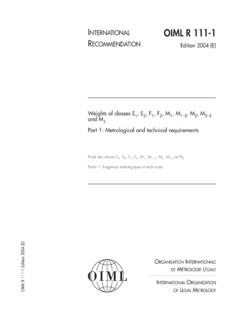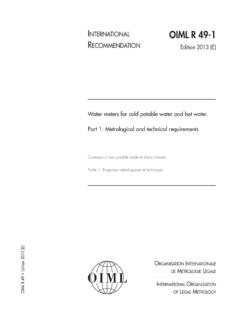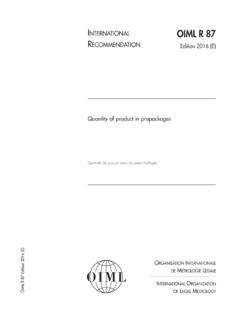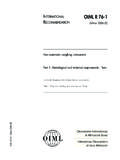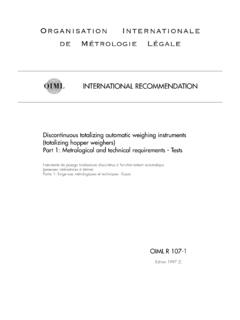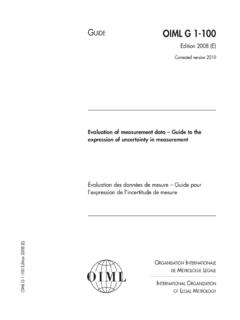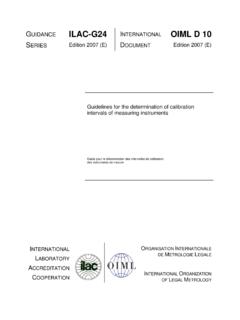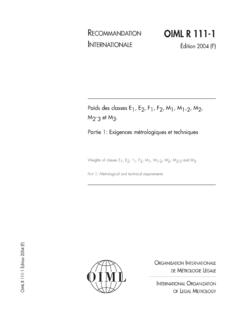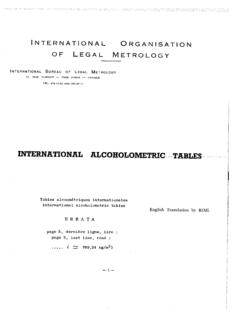Transcription of OIML R 111-1 (E) Edition 2004
1 INTERNATIONAL oiml R 111-1 . RECOMMENDATION Edition 2004 (E). Weights of classes E1, E2, F1, F2, M1, M1 2, M2, M2 3. and M3. Part 1: Metrological and technical requirements Poids des classes E1, E2, F1, F2, M1, M1 2, M2, M2 3 et M3. Partie 1: Exigences m trologiques et techniques oiml R 111-1 Edition 2004 (E). ORGANISATION INTERNATIONALE. DE M TROLOGIE L GALE. INTERNATIONAL ORGANIZATION. OF LEGAL METROLOGY. oiml R 111-1 : 2004 (E). Contents Foreword .. 3. General .. 4. 1 Scope .. 4. 2 Terminology .. 5. 3 Symbols .. 8. 4 Units and nominal values for weights.
2 11. Metrological requirements .. 11. 5 Maximum permissible errors on verification .. 11. Technical requirements .. 13. 6 Shape .. 13. 7 Construction .. 14. 8 Material .. 15. 9 Magnetism .. 16. 10 Density .. 17. 11 Surface conditions .. 18. 12 Adjustment .. 19. 13 Marking .. 20. 14 Presentation .. 21. Metrological controls .. 22. 15 Submission to metrological controls .. 22. 16 Control marking .. 23. Annex A Examples of different shapes and dimensions .. 25. Annex B Test procedures for weights .. 28. Introduction .. 28. Test sequence.
3 28. Document review and visual inspection .. 28. Cleaning weights .. 29. Surface roughness .. 30. Magnetism .. 33. Density .. 42. Assignment of an oiml R 111 class to old and/or special weights .. 60. Annex C Calibration of a weight or weight set .. 61. Scope .. 61. General requirements .. 61. Weighing designs .. 62. Weighing cycles .. 63. Data analysis .. 65. Uncertainty calculations .. 66. Annex D Statistical control .. 71. Check standard .. 71. Precision of the balance .. 72. Annex E CIPM formula and an approximation formula.
4 74. CIPM formula .. 74. Constants .. 74. Approximation formula for air density .. 76. References .. 77. 2. oiml R 111-1 : 2004 (E). Foreword T. he International Organization of Legal Metrology certain institutions, such as ISO and IEC, with the objective ( oiml ) is a worldwide, intergovernmental organization of avoiding contradictory requirements; consequently, manu- whose primary aim is to harmonize the regulations and facturers and users of measuring instruments, test labor- metrological controls applied by the national metrological atories, etc.
5 May apply simultaneously oiml publications services, or related organizations, of its Member States. and those of other institutions. International Recommendations and International Docu- The two main categories of oiml publications are: ments are published in French (F) and English (E) and are International Recommendations ( oiml R), which are subject to periodic revision. model regulations that establish the metrological charac- This publication - oiml R 111-1 , Edition 2004 (E) - was teristics required of certain measuring instruments and developed by TC 9/SC 3 Weights.
6 It was directly sanctioned by which specify methods and equipment for checking their the International Conference of Legal Metrology in 2004 . conformity; the oiml Member States shall implement oiml Publications may be downloaded from the oiml web these Recommendations to the greatest possible extent;. site in the form of PDF files. Additional information on International Documents ( oiml D), which are inform- oiml Publications may be obtained from the Organization's ative in nature and intended to improve the work of the headquarters: metrology services.
7 Bureau International de M trologie L gale oiml Draft Recommendations and Documents are devel- 11, rue Turgot - 75009 Paris - France oped by technical committees or subcommittees which are Telephone: 33 (0)1 48 78 12 82. formed by Member States. Certain international and regional Fax: 33 (0)1 42 82 17 27. institutions also participate on a consultation basis. E-mail: Cooperative agreements are established between oiml and Internet: 3. oiml R 111-1 : 2004 (E). Weights of classes E1, E2, F1, F2, M1, M1 2, M2, M2 3 and M3. General 1 SCOPE.
8 This Recommendation contains technical ( principal physical characteristics) and metrological re- quirements for weights used: As standards for the verification of weighing instruments;. As standards for the verification or calibration of weights of a lower accuracy class;. With weighing instruments. Application This Recommendation applies to weights with nominal values of mass from 1 mg to 5 000 kg in the E1, E2, F1, F2, M1, M1 2, M2, M2 3 and M3 accuracy classes. Minimum accuracy class of weights The accuracy class for weights used as standards for the verification of weights or weighing instruments should be in accordance with the requirements of the relevant oiml Recommendations.
9 The oiml weight classes are defined as follows: Class E1: Weights intended to ensure traceability between national mass standards (with values derived from the International Prototype of the kilogram) and weights of class E2 and lower. Class E1. weights or weight sets shall be accompanied by a calibration certificate (see ). Class E2: Weights intended for use in the verification or calibration of class F1 weights and for use with weighing instruments of special accuracy class I. Class E2 weights or weight sets shall be accom- panied by a calibration certificate (see ).
10 They may be used as class E1 weights if they com- ply with the requirements for surface roughness, magnetic susceptibility and magnetization for class E1 weights, and if their calibration certificate gives the appropriate data as specified in Class F1: Weights intended for use in the verification or calibration of class F2 weights and for use with weighing instruments of special accuracy class I and high accuracy class II. Class F2: Weights intended for use in the verification or calibration of class M1 and possibly class M2. weights.
